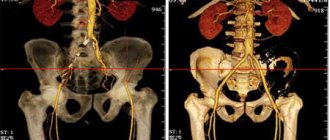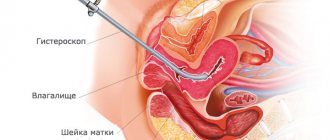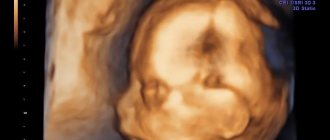Ekaterina Smolnikova
Practicing endocrinologist (10 years of experience). He has extensive experience working in private and public clinics in Russia.
Ask a Question
Last updated - July 31, 2020 at 03:16 pm
Screening examination: what is it and for what purpose is it performed? People ask this question often. Many have heard about the concept of screening and consider it necessary for expectant mothers. This type of test is also used for children and sometimes for men. You can understand the essence of the test by studying the procedure and types of screening.
What does screening mean?
Screening refers to a medical examination of people who do not complain about their health; the goal is to identify diseases. Such a survey is carried out in most budgetary institutions, and in most cases free of charge. To undergo a screening examination, you must be assigned to a clinic.
This testing method allows pathologies to be detected at an early stage and increases the likelihood of disease prevention.
The study allows us to identify diseases such as:
- diabetes in men as well as women;
- glaucoma;
- neoplasms;
- hepatitis in the body;
- pathologies of the circulatory system;
- hepatitis.
These are just the main areas that screening studies reveal. There are a number of other diseases that are also detected by this method.
There is mass screening and random screening. Typically, a sample survey concerns only one family or group of people where there is a risk of contracting a particular disease.
This type of study reveals the presence of the disease at a stage when symptoms do not yet make themselves felt.
Who needs to do it?
Another common question is in what week should screening be done and who needs it. This type of examination is necessary when, during a routine ultrasound, a specialist notices some deviations from the norm.
There are a number of specific indications taken into account before conducting the study. If there are serious hereditary pathologies in the family of one of the future parents, ultrasound screening is a prerequisite.
It is recommended for women over 35 years of age to seek such ultrasound diagnostics.
Sometimes there are cases when spouses are relatives. In such a situation, the procedure is a prerequisite.
If, before planning conception, one of the spouses was exposed to ionizing radiation, it is necessary to undergo the procedure.
Another indication for this is the presence of diseases such as rubella, chickenpox, and herpes during pregnancy. Conducting such an examination is not compulsory, and each person can apply for it at his own request.
Screening examination during pregnancy
If checking the health of the population is a new program and only those who want to undergo it, then for expectant mothers, identifying the presence of pathologies is extremely important. Many pregnant women have doubts about a screening examination, not knowing what it is and how to prepare for it.
A comprehensive check includes examinations using an ultrasound diagnostic device and blood tests. Based on them, the length of the fetus, the period from conception to examination, and the presence of abnormalities in the baby are determined.
One of the important components of screening surveillance is the first check at the beginning of pregnancy.
First screening: what is it?
The first check is important for the expectant mother, as it confirms the presence of pregnancy. During this period, doctors try to identify deviations of the following nature:
Article on the topic:
The hormone prolactin. Normal in the female body depending on age
- Checking the length of the nose, since in those children who develop with deviations, the bones form later.
- Checking the gall sac and the number of heartbeats. This indicates the viability of the child.
- The condition of the neck fold, which often indicates developmental abnormalities, is kept under control.
- The state of blood flow to the fetus.
- Head size is also important for diagnosis.
- Checking the gestational age according to the table.
Important! Deviations identified during the first screening should not give cause for concern. If abnormal development is suspected, the woman will be examined more intensively and a final diagnosis will be given.
The examination is carried out both transvaginally and through the abdominal wall. Since the first method of examining the fetus is more informative, it is used in the early stages of pregnancy.
The second stage of screening consists of a detailed biochemical blood test. It is important to note that the expectant mother donates blood only after undergoing an ultrasound, where a specialist determines the gestational age.
The tests assessed in such a study are hCG, a hormone that indicates the presence of pregnancy, and protein-A, which shows the state of the placenta and the woman’s immunity.
After three studies, the doctor displays the MoM index, which also consists of such indicators as:
- mother's age;
- presence of bad habits;
- previous pregnancies.
The doctor prescribes two screenings. If the patient has reasons to undergo the third screening stage, for example, age, over 35 years or health indicators, then she will be examined again.
Second screening
Second screening examination, what is it and why should all expectant mothers do it?
In mid-pregnancy, a woman is tested using a third screening method. The purpose of this examination is to identify the child's position.
As with the first ultrasound screening, the size of the baby’s nasal bone and other indicators of the child are determined.
The pregnant woman is also given close attention. A gynecologist is examining her. This applies to identifying swelling and eliminating excess weight, which complicate the period of gestation.
The cervix and walls of the uterus are examined for the presence of pathological and inflammatory processes, which also affects the condition of the expectant mother.
During this period, three test indicators are looked at and compared with norms: the level of hCG, AFP (fetal blood serum protein) and estriol.
HCG is checked using a special table, where the indicators correspond to the period of gestation. If the result obtained is different from the norm, then there is a possibility of miscarriage. Therefore, if doubt arises, the result will be shown to the gynecologist and other specialists examining the condition of the expectant mother.
Article on the topic:
What is alpha fetoprotein analysis? How and when to take it?
Estriol is also compared with the values from the table. This hormone shows the condition of the fetus' liver and its mother's placenta. Subsequently, this hormone takes part in the formation of ducts for the passage of milk for feeding.
AFP analysis is done to check the following factor: whether the child is producing protein correctly or not.
Third screening
If the tests are favorable and there are no complaints, the expectant mother does not pass the third test. The next stage is screening the baby after birth.
In case of obvious pathologies and test results that differ from the norm, the woman is recommended to undergo a third screening, which reveals the condition of the placenta and the position of the fetus.
How is first trimester screening performed?
The first screening examination is performed from 11 to 14 weeks. The correctly established gestational age is of particular importance, since the screening limits vary with each subsequent week. The first screening includes a routine ultrasound diagnosis of the fetus and a biochemical examination of the mother’s venous blood. The interval between studies should be no more than 3 days. An integrated approach will allow you to determine the presence of possible anomalies with maximum accuracy.
First ultrasound screening
During an ultrasound examination, the doctor examines the location of the chorion (the membrane of the embryo), the tone of the uterus and the condition of the ovaries. The degree of development of the child’s spine and brain and the presence of limbs are determined. In case of multiple pregnancy, the doctor will identify fraternal or identical twins in the womb. In addition, ultrasound can identify some developmental anomalies that are incompatible with life. For example, anencephaly, which is characterized by partial or complete absence of the cerebral hemispheres or cranial bones, and a lack of soft tissue.
Biochemical screening analysis
To conduct the study, venous blood is used, which is taken on an empty stomach in the morning. A double test is aimed at determining the amount of PAPP-A and beta hCG in the blood.
The hCG hormone has two parts: (α) alpha and (β) beta. For prenatal screening, β-hCG is of greatest importance, the indicators of which are used to detect serious abnormalities in fetal development. If pregnancy proceeds without pathologies, the β-hCG marker is within acceptable limits. Each week of gestation has its own normative values. A decrease or increase in hormone concentration may indicate an unfavorable course of pregnancy.
The increase in hCG levels is explained by the following factors:
- Incorrect gestational age;
- Multiple pregnancy;
- Early toxicosis;
- Down syndrome or other chromosomal abnormalities in the child;
- Diabetes mellitus in the mother.
A decrease in hormone levels may indicate the presence of the following pathologies:
- Risk of miscarriage;
- Development of ectopic pregnancy;
- Placental insufficiency;
- Presence of Edwards syndrome.
It should be taken into account that hCG levels during in vitro fertilization will be higher than in women whose pregnancy occurred through natural conception.
Another integral part of the first trimester screening analysis is the measurement of PAPP-A protein. It is necessary to ensure the development and activity of the placenta. A decrease in this protein may indicate regression of pregnancy, the likelihood of spontaneous abortion, the presence of chromosomal mutations and some monogenic syndromes. Exceeding PAPP-A levels may be the cause of an incorrectly set gestation period and increased uterine tone.
The results obtained during the first screening cannot be used as indications for termination of pregnancy. The likelihood of developing a pathology does not guarantee the birth of a child with disorders. Deviations from standards are a reason for additional research. The patient is referred to a geneticist, who, after studying the medical history, as well as the results of ultrasound and biochemical diagnostics, decides on the advisability of laboratory tests requiring surgical intervention (biopsy or amniocentesis of the placenta, chorion).
The difference between screening and ultrasound
A perinatal screening study involves examining all pregnant women, and this rule does not depend on the patient’s health.
At first glance, it may seem that there are no differences between ultrasound and screening, since both studies are carried out on the same device. The difference is in the approach to the research method and the decoding method. Screening takes into account not only ultrasound diagnostic indicators, but also biochemical blood tests.
The first test consists of an ultrasound examination and testing for two hormones, and the second test consists of an ultrasound examination and obtaining the results of three hormones.
Important! An ordinary ultrasound examination shows the condition of the expectant mother's organ, not the fetus.
These two studies pose different challenges.
Which of the three examinations is the most important?
Because prenatal screenings are recommended for all women at certain stages of pregnancy, it is impossible to single out which one is most important.
If the examination is carried out with the aim of preventing the birth of a baby with chromosomal and other pathologies (for example, cleft palate or cleft lip, although all this can be corrected today), then, of course, it is advisable to find out about damage to the fetus as early as possible. In this sense, the importance of the first screening is extremely high, since late abortions are fraught with serious complications for the woman.
During second trimester screening, the risk of neural tube defects is calculated (in the early stages there are no markers of this phenomenon) and, again, trisomies, so it also cannot be excluded from the examination program.
Finally, prenatal screening shows the readiness of both the child and the expectant mother for childbirth, on the basis of which the doctor makes a decision on the methods of delivery (naturally or via cesarean section).
Mammography screening
Every woman should undergo a mammography examination. This will allow you to identify changes and lumps in the breast, as well as begin timely treatment.
Women are advised to conduct diagnostic self-examinations at home and identify small lumps, and then contact a mammologist. Many people forget about this procedure, so doctors urge you to remember the annual examination.
Examinations are carried out in medical institutions. Most often, this issue is dealt with by a mammologist or gynecologist.
Mammography, performed using a special device, is similar to fluorography, but the focus is not on the chest, but on the woman’s mammary glands.
During the study, the woman undresses and presses her chest against the device, after which the laboratory assistant takes a photo. Subsequently, the result obtained is transferred to a mammologist or therapist, who interprets it.
This method has many positive reviews, but some experts have noticed that the reliability of the method is about 20%. Subsequently, patients receive a false positive result and nervous disorders, and a painful biopsy causes physical pain.
Article on the topic:
What is anti-Mullerian hormone responsible for? What are the normal AMH values in the female body?
In addition, the radiation used when taking the image affects the mammary glands and, with frequent examinations, can lead to oncology that occurs in the breast area.
Many patients, for the reasons listed above, refuse such a study, but doctors strongly advise not to forget about the annual examination, which brings only benefit and not harm.
Cervical cancer.
It occurs frequently, so examination should be carried out regularly, especially if a woman has previously been diagnosed with human papillomavirus (HPV).
Who's at risk
: women infected with human papillomavirus. HPV is detected in 100% of cancer patients. Moreover, human papillomavirus strains 16 and 18 are responsible for 70% of cases of cervical cancer.
What examination:
The most important screening test is the Pap test. This is a study of scraping from the cervix, which is carried out for cytology (changed cells). The test is quite simple, not painful, and is done during an appointment with a gynecologist.
How often
: with periodic examination of girls and women 3 years after the start of sexual activity, but no later than 21 years (it is recommended to take an analysis annually and at least every 3 years). Every 2–3 years, starting at age 30 until age 65 with three consecutive negative results.
Every year if you have the human papillomavirus (HPV), or if your immune system is weakened by transplantation, chemotherapy, or long-term use of steroid hormones.
“In order to reduce the risk of cervical cancer, you need to get vaccinated,” says Alexander Galperin. — Vaccination is primarily necessary before the start of sexual activity. It is allowed from the age of 9, but is usually done for 12-13 year olds. Additionally, it is recommended that young sexually active women under 25–26 years of age be vaccinated: this is exactly what happened in Australia when, in addition to teenage girls, young girls also began to be vaccinated. It makes sense to vaccinate older women as well. It has been proven that the vaccine will not cause harm. The vaccine is administered 3 times, the second and third doses are administered 2 months and 6 months after the first. In the United States and in some European countries, doctors recommend that boys also be vaccinated against HPV so that they are not carriers (however, there is no evidence that the presence of HPV can cause cancer in boys). To date, this is the only vaccine that fights cancer. But it is not on the national calendar.
Heart screening
The doctor may prescribe the patient to undergo a screening test to detect heart disorders, if there are objective reasons for this. These include:
- Excess weight.
- Chronic illness.
- Heart disease.
- Hereditary factor.
- A disorder in the heart muscle.
One of the most accurate methods of modern detection of heart problems is electrocardiography. The study has been used for more than five years, and it brings results in identifying the pathological process in the cardiovascular system.
One part of the device records electric fields, located on the patient’s chest and back, and the second is designed to record changes in electric fields.
The second method is ultrasound diagnostics. The sensor is placed in the patient's heart area, and the doctor sees an image on the screen. When assessing the image, the specialist compares the dynamics and parameters of the heart with the norm.
Irregular rhythm and thinning of tissue indicate disturbances in the heart area.
Sometimes the heart is examined through the esophagus. This examination is more informative than identifying an image using a sensor, but it causes discomfort for the patient.
Muscles absorb radiation from the sensor, and bones are a kind of obstacle that prevents you from getting the full result.
Since ultrasound has a small penetration radius, examination through the transesophageal route is recommended for people suffering from excess weight.
Diagnosis is carried out on an empty stomach, which avoids the gag reflex.
About authenticity
With the greatest reliability, 85%, this analysis shows Wegener's granulomatosis, followed by microscopic polyangiitis, with positive analysis data, its reliability is also 82% of agreement with clinical data.
There are also false positive results, for example, with ulcerative colitis and Crohn's disease, 8% of patients may have a positive result. It must be remembered that all test results that turn out to be positive should be assessed only in conjunction with clinical signs. If they are pronounced, then this analysis helps confirm the diagnosis, but if in patients these signs are doubtful, then a negative result allows us to refuse to make a diagnosis of systemic vasculitis.
Advantages of screening diagnostics
The advantages of diagnostics performed in the form of a screening study are obvious. This method contributes to the timely detection of disorders and the prompt prescription of competent therapy to eliminate the pathological process.
By examining the heart, chest, and other organs, people can gain information about their body's health and begin therapeutic interventions.
Identification of diseases at the initial stages of their development leads to the possibility of their successful cure if modern and qualified treatment is applied.
Carrying out analysis
Screening usually takes place in two stages. The first involves an ultrasound examination. Only after receiving the ultrasound results can you go for a blood test. Usually, the results of biochemical screening can be obtained only after a fairly long time - from one and a half to three weeks. In private clinics, analysis can be carried out in an accelerated time frame - up to a week.
Is screening mandatory for pregnant women? Screening is a recommendatory examination of a pregnant woman. On the one hand, thanks to such a simple and safe study, it is possible to detect serious pathologies in the baby’s development in the early stages. But at the same time, diseases determined in this way cannot be treated. In addition, the results only indicate the degree of risk for developing disorders and do not constitute a diagnosis. If abnormalities are detected, the expectant mother faces a difficult choice regarding the further development of the pregnancy. Therefore, the final decision regarding undergoing such an examination can only be made directly by the future parents.
Screening of pregnant women: what diseases can be detected during the analysis?
Screening is a comprehensive examination of pregnant women that allows you to identify most hereditary diseases. Screening procedures are carried out at periods when it is still safe to terminate the pregnancy.
The following types of screening are distinguished:
- Ultrasonic;
- Biochemical;
- Combined.
The first type involves an ultrasound examination. The second type includes a blood test for hCG, free estriol, and AFP. Combined screening combines both types of these studies in a complex.
The following types of screening are distinguished:
Decoding the results: normal and pathological
The results are deciphered by the specialist supervising the pregnant woman. When decoding indicators, he takes into account all factors that could influence their change, including age, bad habits, gynecological and chronic anamnesis, consanguineous marriage, and so on. If there are any doubts about what this or that sign means, a medical consultation is held.
After complete interpretation of the data, future parents are invited and the situation is covered in detail, including the likelihood of the presence of chromosomal pathologies. The doctor informs about the plan for monitoring the pregnant woman in the next 9 (or less) months.
If screening reveals alarming signs of serious defects, then the decision to terminate pregnancy is made jointly. In this case, the woman must sign a document stating that she agrees to medical intervention voluntarily.











